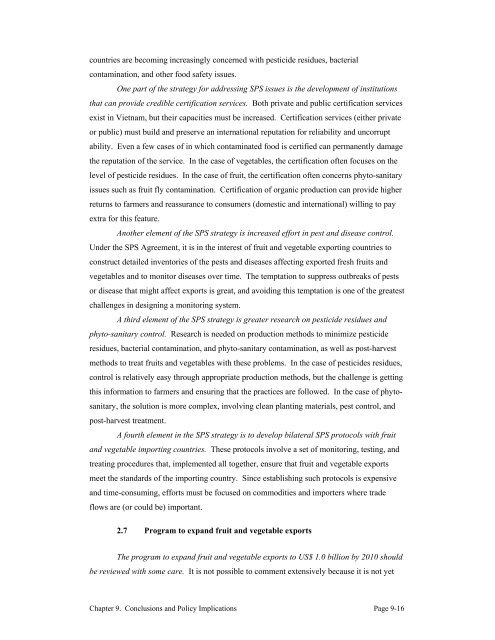Fruits and Vegetables in Vietnam - International Food Policy ...
Fruits and Vegetables in Vietnam - International Food Policy ...
Fruits and Vegetables in Vietnam - International Food Policy ...
Create successful ePaper yourself
Turn your PDF publications into a flip-book with our unique Google optimized e-Paper software.
countries are becom<strong>in</strong>g <strong>in</strong>creas<strong>in</strong>gly concerned with pesticide residues, bacterial<br />
contam<strong>in</strong>ation, <strong>and</strong> other food safety issues.<br />
One part of the strategy for address<strong>in</strong>g SPS issues is the development of <strong>in</strong>stitutions<br />
that can provide credible certification services. Both private <strong>and</strong> public certification services<br />
exist <strong>in</strong> <strong>Vietnam</strong>, but their capacities must be <strong>in</strong>creased. Certification services (either private<br />
or public) must build <strong>and</strong> preserve an <strong>in</strong>ternational reputation for reliability <strong>and</strong> uncorrupt<br />
ability. Even a few cases of <strong>in</strong> which contam<strong>in</strong>ated food is certified can permanently damage<br />
the reputation of the service. In the case of vegetables, the certification often focuses on the<br />
level of pesticide residues. In the case of fruit, the certification often concerns phyto-sanitary<br />
issues such as fruit fly contam<strong>in</strong>ation. Certification of organic production can provide higher<br />
returns to farmers <strong>and</strong> reassurance to consumers (domestic <strong>and</strong> <strong>in</strong>ternational) will<strong>in</strong>g to pay<br />
extra for this feature.<br />
Another element of the SPS strategy is <strong>in</strong>creased effort <strong>in</strong> pest <strong>and</strong> disease control.<br />
Under the SPS Agreement, it is <strong>in</strong> the <strong>in</strong>terest of fruit <strong>and</strong> vegetable export<strong>in</strong>g countries to<br />
construct detailed <strong>in</strong>ventories of the pests <strong>and</strong> diseases affect<strong>in</strong>g exported fresh fruits <strong>and</strong><br />
vegetables <strong>and</strong> to monitor diseases over time. The temptation to suppress outbreaks of pests<br />
or disease that might affect exports is great, <strong>and</strong> avoid<strong>in</strong>g this temptation is one of the greatest<br />
challenges <strong>in</strong> design<strong>in</strong>g a monitor<strong>in</strong>g system.<br />
A third element of the SPS strategy is greater research on pesticide residues <strong>and</strong><br />
phyto-sanitary control. Research is needed on production methods to m<strong>in</strong>imize pesticide<br />
residues, bacterial contam<strong>in</strong>ation, <strong>and</strong> phyto-sanitary contam<strong>in</strong>ation, as well as post-harvest<br />
methods to treat fruits <strong>and</strong> vegetables with these problems. In the case of pesticides residues,<br />
control is relatively easy through appropriate production methods, but the challenge is gett<strong>in</strong>g<br />
this <strong>in</strong>formation to farmers <strong>and</strong> ensur<strong>in</strong>g that the practices are followed. In the case of phytosanitary,<br />
the solution is more complex, <strong>in</strong>volv<strong>in</strong>g clean plant<strong>in</strong>g materials, pest control, <strong>and</strong><br />
post-harvest treatment.<br />
A fourth element <strong>in</strong> the SPS strategy is to develop bilateral SPS protocols with fruit<br />
<strong>and</strong> vegetable import<strong>in</strong>g countries. These protocols <strong>in</strong>volve a set of monitor<strong>in</strong>g, test<strong>in</strong>g, <strong>and</strong><br />
treat<strong>in</strong>g procedures that, implemented all together, ensure that fruit <strong>and</strong> vegetable exports<br />
meet the st<strong>and</strong>ards of the import<strong>in</strong>g country. S<strong>in</strong>ce establish<strong>in</strong>g such protocols is expensive<br />
<strong>and</strong> time-consum<strong>in</strong>g, efforts must be focused on commodities <strong>and</strong> importers where trade<br />
flows are (or could be) important.<br />
2.7 Program to exp<strong>and</strong> fruit <strong>and</strong> vegetable exports<br />
The program to exp<strong>and</strong> fruit <strong>and</strong> vegetable exports to US$ 1.0 billion by 2010 should<br />
be reviewed with some care. It is not possible to comment extensively because it is not yet<br />
Chapter 9. Conclusions <strong>and</strong> <strong>Policy</strong> Implications Page 9-16
















